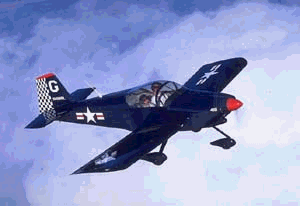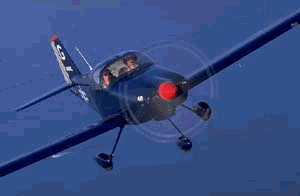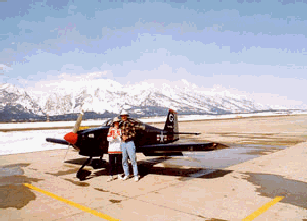The Homebuilt Decision: Would You Buy a Used Airplane Built in a Garage?
By Bob Warner (originally published in EAA Sport Aviation, July 1999)
Sometimes it becomes necessary to say goodbye to an old friend - not human ones, of course, but rather inanimate ones.
Our 1947 Stinson 108-3 had served us well for nine years, but its fabric was growing weary and my wife, Noel Marshall, and I were feeling the "need for speed" or, rather, we were hoping to expand our range.
Decision time. Keep the Stinson and restore it, or buy a different airplane? Were we still content to continue our short joy rides around Wisconsin, sharing many with our friends, or were we interested in moving on to something different? Almost a year of discussions about time, money and priorities contributed to a new series of questions about whether our "flight mission" had changed over the years. It didn’t take long for us to agree on our new mission: An economical, quick, cross-country, comfortable aircraft with enough room in the baggage compartment for weekend gear and our 13-pound dog, Reggie. This would meet the requirements for an aircraft that would get us from Oshkosh to the Washington, D.C. area (where our parents live) in a reasonable amount of time. Both Noel and I enjoy traveling, and the number of "neat places to visit" would grow exponentially with some more speed.
We began listing all the possible aircraft makes and models and eventually pared the list down to about 200 choices - the vast majority being homebuilts.
Time for another layer of discussion and decisions. Homebuilts generally are more economical to maintain and operate than type certificated aircraft because of the privileges (and responsibilities) of more allowed owner maintenance, and there’s the opportunity to use "non-approved" components and auto fuel.
While intriguing, the option of building our own homebuilt was not a rational one; we simply don’t have the time. If our final choice became a homebuilt, our only option would be to buy a used one.
Used Homebuilts Becoming Popular
The decision to buy a used homebuilt is becoming an increasingly popular one. With over 20,000 experimental amateur-built aircraft on the FAA Registry, the range of opportunity to find a make and model that fits the type of flying you do is greater than ever.
But, while the magazine advertisements luring you to buy a kit plane rather than a production aircraft look much the same - promising speed, economy, and a chance to be more popular among your friends - there are vast differences between production (type certificated) aircraft and their homebuilt cousins.
Like anyone considering purchasing a homebuilt should, we thought long and hard about those differences. The major difference is the actual government certification standards. The "store-bought plane" is a government-approved design, built in a government-approved factory and signed off by a government representative who attests that it is identical to the original, highly tested production prototype.
While a homebuilt may, in fact, exceed the design criteria of a particular government category, it need not meet any standard. And, of course, in the United States the "manufacturing facility" of a homebuilder, a garage or basement, is not required to meet any standard.
Another major difference, which can be both an advantage or a disadvantage, is the operating envelope of the aircraft. Human beings are very adaptable, and pilots are capable of "making up the difference" in how an aircraft behaves in flight; however, it is important to know that the flight characteristics between a homebuilt and production aircraft can be vastly different.
Using the Resources of EAA
You would think a guy who is the Executive Vice President of EAA would know all about homebuilts and jump right into building or buying one. But my conservative and analytical personality traits caused us to move slowly. After all, my "job" at EAA is one of association management and my personal aviation experience has been more with production aircraft - having owned six production airplanes since 1977
As an EAA staffer, I had access to every single resource available to my fellow members, which was a constant benefit. A check with the staff in EAA Aviation Information Services helped answer my questions about safety issues and the basics of FAA registration. They also provided us with a list of builders of the models we were seriously considering. A search of the EAA website "Members Only Area" provided us with a list of model-specific articles that have appeared in EAA publications. It was time for a lot of reading and networking with owners of the homebuilt models we were considering. We had many conversations with other EAAers.
Another great resource for EAAers is the opportunity to go "knowledge shopping" at the thousands of EAA fly-in events throughout the world. While I was a bit busy with official duties at EAA AirVenture Oshkosh, the EAA Golden West Regional Fly-In, and the Southwest Big Country Fly-In at Abilene, I always found a few minutes to pick the brain of more experienced homebuilt owners.
With nearly 1,000 EAA Chapters in existence around the world, meaning lots of fly-in breakfasts and other such events, the great majority of EAA members have the opportunity for this kind of networking "locally." If you are thinking of buying a used homebuilt (or building one) and are not a Chapter member, it’s well worth your time to consider how to take advantage of that vast experience in your local area. My fellow EAA staffers, in many ways, served as my EAA Chapter.
As we continued narrowing our list of potential aircraft, our options were weighing heavily toward homebuilts. More in-depth research was important. We began contacting the aircraft type clubs for our "favorite" models, and checked out their newsletters and websites to learn specific information about those particular aircraft. Another major consideration was insurance. A call to Avemco, EAA’s approved insurance company, provided us with information on the safety records of those makes and models.
The bottom line in making the decision to buy a homebuilt, be it new or used, is gaining the confidence to know which make and model is right for the type of flying you do and the type of pilot and aircraft owner you are.
Which RV-6A?
Eventually, we settled on the RV-6A as our model of choice. Why the RV-6A? Simply, it met all our criteria, including the potential for Noel to renew her flying with a nose wheel airplane after a 13-year lapse. Like everything in life, there is rarely a perfect match; we did have to give up having two extra seats for our friends, but in all other ways, the RV-6A fit the bill.
Now, which of the dozens of -6As listed in Trade-A-Plane to buy? Even with a simple plane like this, buying "used" is like buying a used car. There were many factors to consider: The condition of the plane; what types of radios; electric vs. manual trim and flaps; do we like the paint job? These choices were all compromises in the decision to buy used rather than building it yourself.
Putting the cosmetic and operational issues aside, one of the most important elements for us -as it should be for anyone contemplating purchasing a used plane - was our confidence in the construction of the aircraft. I must admit there is a certain level of trust inherent in knowing the employees of Clyde Cessna or Eddie Stinson had to conform to an FAA-approved type certificate with every single airplane that came off the production line. With a homebuilt, at some time you’re likely to face this question at a neighborhood barbecue - "You bought an airplane from someone you don’t know who built it in their garage?"
Here’s where being an EAA member has another major benefit. It was time to tap into the resources of the EAA Technical Counselor Program. EAA Technical Counselors are experienced builders or mechanics who volunteer their time to mentor builders and restorers, providing the benefit of their knowledge. Most Technical Counselors are affiliated with Chapters, although there are also many "at large" Technical Counselors.
While it may be common to think of Technical Counselors as folks who only help builders, we found a new, important value for these experienced volunteers. We were fortunate to be able to talk many times with the Technical Counselor who oversaw the construction of the specific plane that we eventually purchased. In fact, it was a major selling point for us when that builder, who had completed the aircraft in August of 1997 and flown it for more than 70 hours, gave us the name of his Technical Counselor to discuss the specifics of the airplane. Not everyone contemplating a purchase will have the convenience of the Technical Counselor for their aircraft available, however, conversing with any Technical Counselor can help a potential purchaser determine what to look for and what questions to ask about any of the airplanes being considered.
In our case, conversations with RV-6A designer Dick VanGrunsven reinforced the value of having a Technical Counselor oversee the construction effort, particularly for a first-time builder, which was the case with our airplane. In fact, we may have talked more to the Technical Counselor than to the builder himself!
The RV-6A we were considering was based at the Caldwell, Idaho airport, some 1,300 miles from our home in Oshkosh. Having the Technical Counselor available as an on-site advisor was a great help; however, when buying any aircraft 1,300 miles from home, the prudent purchaser should always have a disinterested third party do a "pre-purchase inspection." While many mechanics and repair stations are not comfortable inspecting a homebuilt, it is important to find one who will review the construction and past maintenance practices for the aircraft. Sometimes they can also evaluate the construction process by reviewing the construction notebook. In our case, the mechanic placed high value on the involvement of other experienced builders who helped our first-time builder with his plane. His advice was also helpful, for example, in ensuring an appropriate break-in routine for the recently overhauled engine.
Am I Ready To Fly This Thing?
After flying for 31 years and with nearly 3,000 hours in a variety of planes, my attitude could have been, "Of course I can fly this plane." I’ve owned Cessnas and taildraggers for 20-plus years. This could be the attitude of many pilots, but it’s a foolish attitude. A study of the track record of pilots with low levels of experience in any make and model of aircraft suggests you have increased odds of being first at the scene of an accident or incident without appropriate transitional training.
Prudence dictates that anyone moving from one type of flying machine to another should gain experience via the oversight of other competent individuals. Whether moving from a type-certificated airplane to an ultralight, from a nosewheel plane to a tailwheel plane, or a conservatively behaving type-certificated plane to a higher performance homebuilt, it is important to match the pilot’s experience and proficiency with the aircraft.
A wealth of such experience resides in EAA and its affiliate, the National Association of Flight Instructors (NAFI). Nothing beats having time in the exact make and model of plane you’re contemplating purchasing. For me, there was the opportunity to fly another RV-6A locally. I selected a flight instructor with time in type and flew with him for check-outs that exceeded insurance requirements and our combined personally set expectations.
For the homebuilder, this is where EAA’s Flight Advisor Program increases your odds for a safe transition into flying a homebuilt. The Flight Advisor Program, like the Technical Counselor Program, is composed of hundreds of flight-experienced volunteers who assist EAAers preparing for their first flight in a homebuilt, recently restored vintage plane, or ultralight. These individuals may or may not be flight instructors, but they do have experience in conducting first flights. In utilizing the structure of the Flight Advisor program, they help a pilot evaluate his or her competencies versus the flight characteristics of a particular aircraft.
As with Technical Counselors, many EAAers may think of this program’s value as only being relevant to someone who recently restored a vintage aircraft or completed a homebuilt. Not so! Flight Advisors can also be very helpful to a purchaser of a previously owned homebuilt or ultralight. In addition to helping a pilot evaluate his level of experience and competency in a particular type of aircraft, the Flight Advisor has the resources of EAA’s list of flight instructors and experienced pilots who have time in that specific make and model.
Unlike the popular RV-6A, many homebuilt designs, because of their low numbers, do not offer the availability of other airplanes to build time in before flying your own. However, Flight Advisors have a list of comparable type-certificated aircraft that have many of the same flight characteristics as certain homebuilts, and they can advise you on the types of experience you should gain to ensure you’re making the right decision for you.
Of course, the final step in pilot preparation is dual in the purchased plane. Our seller recommended a local CFI with whom he had flown, which provided me with a plane-specific checkout and, in our case, a refresher in mountain flying for the trip home.
In purchasing a popular model and having the opportunity to fly that very same model of aircraft, I had the best of all worlds in preparing for the purchase of the RV-6A. My advice to anyone considering the purchase of a homebuilt, whether a low-time pilot or a NASA astronaut, would be to utilize the resources of EAA and the Flight Advisor program specifically. Accident statistics reinforce my opinion.
The Happy Ending/Reflections
The end of our decision making is just the beginning of our flying fun, which Noel has recorded in the accompanying article. The lessons learned from our purchase of Rob Greener’s beautifully constructed RV-6A showed the tremendous resources that are available within EAA to provide the information, confidence and level of competence necessary to make a wise decision whether building a homebuilt or buying a used one.
Lower accident/incident rates are proof that the EAA Technical Counselor and Flight Advisor programs have contributed to improving the safety record in homebuilt aviation. One of the lesser known values of these programs is that which is provided to the potential purchasers of used homebuilts. Perhaps if everyone buying homebuilts asked about the builder’s participation in these programs, more builders would avail themselves of these important safety opportunities. That way, everyone would win in the deal - the original builder, the eventual purchaser, and the homebuilt community’s reputation with the public and government.
Decision made. Purchase accomplished. Let’s go flying!



